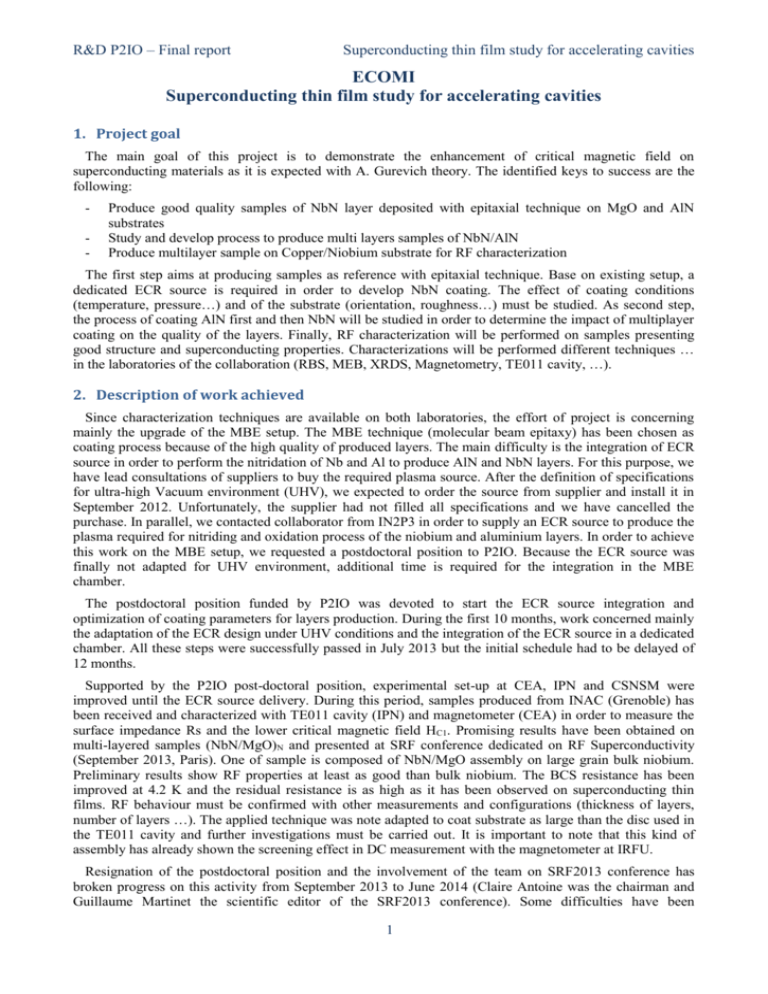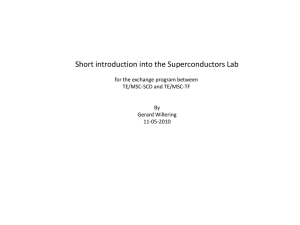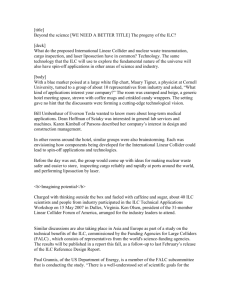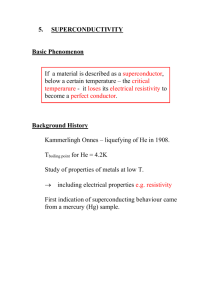P2IO_report_martinet_oct2014
advertisement

R&D P2IO – Final report Superconducting thin film study for accelerating cavities ECOMI Superconducting thin film study for accelerating cavities 1. Project goal The main goal of this project is to demonstrate the enhancement of critical magnetic field on superconducting materials as it is expected with A. Gurevich theory. The identified keys to success are the following: - Produce good quality samples of NbN layer deposited with epitaxial technique on MgO and AlN substrates Study and develop process to produce multi layers samples of NbN/AlN Produce multilayer sample on Copper/Niobium substrate for RF characterization The first step aims at producing samples as reference with epitaxial technique. Base on existing setup, a dedicated ECR source is required in order to develop NbN coating. The effect of coating conditions (temperature, pressure…) and of the substrate (orientation, roughness…) must be studied. As second step, the process of coating AlN first and then NbN will be studied in order to determine the impact of multiplayer coating on the quality of the layers. Finally, RF characterization will be performed on samples presenting good structure and superconducting properties. Characterizations will be performed different techniques … in the laboratories of the collaboration (RBS, MEB, XRDS, Magnetometry, TE011 cavity, …). 2. Description of work achieved Since characterization techniques are available on both laboratories, the effort of project is concerning mainly the upgrade of the MBE setup. The MBE technique (molecular beam epitaxy) has been chosen as coating process because of the high quality of produced layers. The main difficulty is the integration of ECR source in order to perform the nitridation of Nb and Al to produce AlN and NbN layers. For this purpose, we have lead consultations of suppliers to buy the required plasma source. After the definition of specifications for ultra-high Vacuum environment (UHV), we expected to order the source from supplier and install it in September 2012. Unfortunately, the supplier had not filled all specifications and we have cancelled the purchase. In parallel, we contacted collaborator from IN2P3 in order to supply an ECR source to produce the plasma required for nitriding and oxidation process of the niobium and aluminium layers. In order to achieve this work on the MBE setup, we requested a postdoctoral position to P2IO. Because the ECR source was finally not adapted for UHV environment, additional time is required for the integration in the MBE chamber. The postdoctoral position funded by P2IO was devoted to start the ECR source integration and optimization of coating parameters for layers production. During the first 10 months, work concerned mainly the adaptation of the ECR design under UHV conditions and the integration of the ECR source in a dedicated chamber. All these steps were successfully passed in July 2013 but the initial schedule had to be delayed of 12 months. Supported by the P2IO post-doctoral position, experimental set-up at CEA, IPN and CSNSM were improved until the ECR source delivery. During this period, samples produced from INAC (Grenoble) has been received and characterized with TE011 cavity (IPN) and magnetometer (CEA) in order to measure the surface impedance Rs and the lower critical magnetic field HC1. Promising results have been obtained on multi-layered samples (NbN/MgO)N and presented at SRF conference dedicated on RF Superconductivity (September 2013, Paris). One of sample is composed of NbN/MgO assembly on large grain bulk niobium. Preliminary results show RF properties at least as good than bulk niobium. The BCS resistance has been improved at 4.2 K and the residual resistance is as high as it has been observed on superconducting thin films. RF behaviour must be confirmed with other measurements and configurations (thickness of layers, number of layers …). The applied technique was note adapted to coat substrate as large than the disc used in the TE011 cavity and further investigations must be carried out. It is important to note that this kind of assembly has already shown the screening effect in DC measurement with the magnetometer at IRFU. Resignation of the postdoctoral position and the involvement of the team on SRF2013 conference has broken progress on this activity from September 2013 to June 2014 (Claire Antoine was the chairman and Guillaume Martinet the scientific editor of the SRF2013 conference). Some difficulties have been 1 R&D P2IO – Final report Superconducting thin film study for accelerating cavities encountered in finding applicant to replace postdoctoral position. Activities are progressing since summer 2014 with the commissioning of the ECR source in UHV conditions and improvement of the magnetometers setup. First samples should be produced with MBE technique by the end of the year 2014 and we expect to find a candidate for the last year of the postdoctoral position very soon. Finally, even if scientific program is not yet achieved, this project is a success on the following points: - - The collaboration of IRFU, IPN and CSNM is now acted on this thematic. The work has been presented with oral contribution at SRF2013 in Paris and gives the opportunity to start new collaboration, especially for the simulation on the behaviour of such assemblies. A young doctor has been formed on the thematic and could be a valuable support for sample analysis in the future. The MBE setup will be able to produce reference samples very soon in order to lead systematic measurements, exhibiting main parameters to achieve the enhancement of superconducting properties of accelerating cavities. Regarding RF and magnetometry measurements, challenge is now to investigate a way to decrease the residual resistance of these samples. 3. Publications - C.Z. Antoine, J.C. Villegier, and G. Martinet,"Study of nanometric superconducting multilayers for magnetic field screening applications". Applied Physics Letters, 2013. 102(10): p. 102603. C. Baumier et al., “Multilayers activities at Saclay/Orasy”, proceedings of SRF2013, WEIOC02, Paris, 2013. 4. Relevance of the project within P2IO and specific added value for P2IO (approx. 20 lines) P2IO Labex gives the opportunity to enforce the collaboration between IPN, CSNM and IRFU. It offers a frame to develop the superconducting thin film thematic which is not supported by accelerators projects nor funding agency. This R&D effort is mandatory to identify technological axis to carry out. Upgrades of experimental setups at CSNM, IPN and IRFU put the bases of future works on superconducting layers applied at accelerators physic. The required abilities to lead this work (materials, coating process, surface treatment and analysis, cryogenic, RF, superconductivity …) are dispatched in laboratories. The Labex structure is presently an efficient way to work on this kind of transversal thematic. This collaboration could never carry out this program without the P2IO support. 5. Possible valorization of the project The direct possible valorization is the enhancement of the superconducting accelerating cavities. Cavities manufacturers could use this principle to produce high performances superconducting cavities. It is also possible for facilities using the SRF technologies to upgrade their installation without perform major modifications of the buildings. This enhancement is suitable as alternative to the construction of new installations, especially for superconducting linac structures (Spiral2, XFEL …). 6. Expenses The activity in the P2IO framework has started late in 2012 and the money has started to be spent since June 2012. Regarding this point and because of the difficulties encountered for the plasma source, more than 70% of the total dotation has been spent in June 2014. Considering the scheduled experiments and consumables to purchase, 100% of this amount will be spent in May 2015 to produce first results with MBE technique in June. The present sold of 22690 euros will cover cryo-fluids expenses (above 10000 euros), materials for sample production (large grain bulk niobium, MgO, gas … above 5000 euros) and sample analysis. A part will be used for consumables (vacuum gasket, wires …). This will cover all expenses for the year 2015. 2 R&D P2IO – Final report Superconducting thin film study for accelerating cavities Label CSNSM MBE>4000 euros CSNSM MBE<4000 euros CEA mag. >4000 euros CEA mag. <4000 euros IPNO RF >4000euros IPNO RF<4000euros TOTAL Amount Sold 50000 9350 10000 5500 18075 7840 78075 22690 Engaged 18750 21900 0 4500 0 10235 55385 Total 40650 4500 10235 55385 Table 1: Summarize of expenses of the collaboration 7. Future of the project after P2IO funding The IPN/CSNSM/IRFU collaboration on superconducting thin films materials and widely, materials for accelerators and nuclear physic, is at the beginning. By providing efficient tools for materials characterisation, the P2IO support to PANAMA and ACTIF projects offers the opportunity to investigate deeper on these disciplines. Multi-layer activities try to benefit of this context to find other financial support (ANR, ASTRE, SESAME …). The collaboration will continue at least with the local support of the involved laboratories to cover the consumables expenses and by allocating manpower, which is actually the main difficulty to overcome. 3








